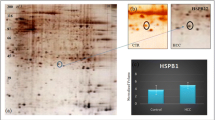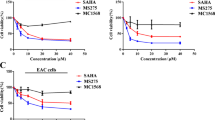Abstract
Purpose
To investigate the differential proteins and related molecular mechanism of CDA-II (cell differentiation agent-II) induced therapy on a human hepatocellular carcinoma model in nude mice with high metastatic potential (LCI-D20).
Methods
After tumors were transplanted 11 days, mice were intraperitoneally injected with CDA-II (1,800 mg/kg) for 20 days continuously. The tumor growth-inhibitory efficiency in CDA-II treated groups was calculated. Proteins extracted from tumor tissue were separated by two-dimensional gel electrophoresis (2DE) and the differential proteins were identified by matrix assisted laser desorption/ionization-time of flight mass spectrometry (MALDI-TOF-MS). Western blotting (WB) was performed to verify the expression of certain candidate proteins. Reverse transcription-polymerase chain reaction (RT-PCR) was engaged to study the molecular mechanism of the therapy.
Results
CDA-II suppressed the growth and metastasis of tumor. The tumor growth-inhibitory efficiency was 41.8%. In total, 27 differentially expressed proteins were identified, including HSP27, UGDH, CK8, Hsp60, ENOA and AnxA5, with functions involved in oncogene expression and/or cell differentiation. In addition, apparent alternations of HSP60 and β-actin expression levels and their different posttranslational modifications (PTMs) were investigated. RT-PCR analysis confirmed that the cancer related genes c-myc, N-ras and MMP-9 were significantly down-regulated.
Conclusion
Our results demonstrate that CDA-II presence can change the proteome profiling and favors of the tumor suppression in LCI-D20 cell differentiation. Our results also suggest that the dynamic PTM of HSP60 expression levels could be used to predict HCC and might be a promising and useful biomarker to prognosticate CDA-II therapeutic efficacy.





Similar content being viewed by others
Abbreviations
- CDA-II:
-
Cell differentiation agent II
- HCC:
-
Hepatocellular carcinoma
- LCI-D20:
-
A nude mice model for human HCC with high metastatic potential (Liver Cancer Institute, passage time 20 days)
- 2DE:
-
Two dimensional gel electrophoresis
- MS:
-
Mass spectrometry
- RT-PCR:
-
Reverse transcription-polymerase chain reaction
- MALDI-TOF-MS:
-
Matrix assisted laser desorption/ionization-time of flight mass spectrometry
References
Bloch A (1984) Induced cell differentiation in cancer therapy. Cancer Treat Rep 68:199–205
Borden EC, Lotan R, Levens D, Young CW, Waxman S (1993) Differentiation therapy of cancer: laboratory and clinical investigations. Cancer Res 53:4109–4115
Cappello F, Di SA, D’Anna SE, Donner CF, Zummo G (2005) Immunopositivity of heat shock protein 60 as a biomarker of bronchial carcinogenesis. Lancet Oncol 6:816
Cappello F, Di SA, David S, Rappa F, Anzalone R, La RG, D’Anna SE, Magno F, Donner CF, Balbi B, Zummo G (2006) Hsp60 and Hsp10 down-regulation predicts bronchial epithelial carcinogenesis in smokers with chronic obstructive pulmonary disease. Cancer 107:2417–2424
Casanova ML, Bravo A, Martinez-Palacio J, Fernandez-Acenero MJ, Villanueva C, Larcher F, Conti CJ, Jorcano JL (2004) Epidermal abnormalities and increased malignancy of skin tumors in human epidermal keratin 8-expressing transgenic mice. FASEB J 18:1556–1558
Chang YS, Wu W, Walsh G, Hong WK, Mao L (2003) Enolase-alpha is frequently down-regulated in non-small cell lung cancer and predicts aggressive biological behavior. Clin Cancer Res 9:3641–3644
Ciocca DR, Calderwood SK (2005) Heat shock proteins in cancer: diagnostic, prognostic, predictive, and treatment implications. Cell Stress Chaperones 10:86–103
Dahlen A, Fletcher CD, Mertens F, Fletcher JA, Perez-Atayde AR, Hicks MJ, biec-Rychter M, Sciot R, Wejde J, Wedin R, Mandahl N, Panagopoulos I (2004) Activation of the GLI oncogene through fusion with the beta-actin gene (ACTB) in a group of distinctive pericytic neoplasms: pericytoma with t(7;12). Am J Pathol 164:1645–1653
Ejeskar K, Krona C, Caren H, Zaibak F, Li L, Martinsson T, Ioannou PA (2005) Introduction of in vitro transcribed ENO1 mRNA into neuroblastoma cells induces cell death. BMC Cancer 5:161
Faried A, Sohda M, Nakajima M, Miyazaki T, Kato H, Kuwano H (2004) Expression of heat-shock protein Hsp60 correlated with the apoptotic index and patient prognosis in human oesophageal squamous cell carcinoma. Eur J Cancer 40:2804–2811
Ghosh AK, Steele R, Ray RB (2005a) Carboxyl-terminal repressor domain of MBP-1 is sufficient for regression of prostate tumor growth in nude mice. Cancer Res 65:718–721
Ghosh AK, Steele R, Ray RB (2005b) c-myc Promoter-binding protein 1 (MBP-1) regulates prostate cancer cell growth by inhibiting MAPK pathway. J Biol Chem 280:14325–14330
Guzman-Aranguez A, Olmo N, Turnay J, Lecona E, Perez-Ramos P, Lopez de SI, Lizarbe MA (2005) Differentiation of human colon adenocarcinoma cells alters the expression and intracellular localization of annexins A1, A2, and A5. J Cell Biochem 94:178–193
King KL, Li AF, Chau GY, Chi CW, Wu CW, Huang CL, Lui WY (2000) Prognostic significance of heat shock protein-27 expression in hepatocellular carcinoma and its relation to histologic grading and survival. Cancer 88:2464–2470
Lebret T, Watson RW, Molinie V, O’Neill A, Gabriel C, Fitzpatrick JM, Botto H (2003) Heat shock proteins HSP27, HSP60, HSP70, and HSP90: expression in bladder carcinoma. Cancer 98:970–977
Li DQ, Wang L, Fei F, Hou YF, Luo JM, Zeng R, Wu J, Lu JS, Di GH, Ou ZL, Xia QC, Shen ZZ, Shao ZM (2006) Identification of breast cancer metastasis-associated proteins in an isogenic tumor metastasis model using two-dimensional gel electrophoresis and liquid chromatography-ion trap-mass spectrometry. Proteomics 6:3352–3368
Li XN, Du ZW, Huang Q, Wu JQ (1997) Growth-inhibitory and differentiation-inducing activity of dimethylformamide in cultured human malignant glioma cells. Neurosurgery 40:1250–1258
Liau MC, Szopa M, Burzynski B, Burzynski SR (1987) Quantitative assay of plasma and urinary peptides as an aid for the evaluation of cancer patients undergoing antineoplaston therapy. Drugs Exp Clin Res 13(Suppl 1):61–70
Lin WC, Liao YC, Liau MC, Lii CK, Sheen LY (2006) Inhibitory effect of CDA-II, a urinary preparation, on aflatoxin B(1)-induced oxidative stress and DNA damage in primary cultured rat hepatocytes. Food Chem Toxicol 44:546–551
Marchal JA, Boulaiz H, Rodriguez-Serrano F, Peran M, Carrillo E, Velez C, Dominguez J, Gomez-Vidal JA, Campos J, Gallo MA, Espinosa A, Aranega A (2007) 5-fluorouracil derivatives induce differentiation mediated by tubulin and HLA class I modulation. Med Chem 3:233–239
Mata-Greenwood E, Ito A, Westenburg H, Cui B, Mehta RG, Kinghorn AD, Pezzuto JM (2001) Discovery of novel inducers of cellular differentiation using HL-60 promyelocytic cells. Anticancer Res 21:1763–1770
Neal CP, Garcea G, Doucas H, Manson MM, Sutton CD, Dennison AR, Berry DP (2006) Molecular prognostic markers in resectable colorectal liver metastases: a systematic review. Eur J Cancer 42:1728–1743
Neuhoff V, Arold N, Taube D, Ehrhardt W (1988) Improved staining of proteins in polyacrylamide gels including isoelectric focusing gels with clear background at nanogram sensitivity using Coomassie Brilliant Blue G-250 and R-250. Electrophoresis 9:255–262
Parikh S, Hyman D (2007) Hepatocellular cancer: a guide for the internist. Am J Med 120:194–202
Parkin DM, Bray F, Ferlay J, Pisani P (2001) Estimating the world cancer burden: Globocan 2000. Int J Cancer 94:153–156
Rutka JT, De Armond SJ, Giblin J, McCulloch JR, Wilson CB, Rosenblum ML (1988) Effect of retinoids on the proliferation, morphology and expression of glial fibrillary acidic protein of an anaplastic astrocytoma cell line. Int J Cancer 42:419–427
Sanna B, Debidda M, Pintus G, Tadolini B, Posadino AM, Bennardini F, Sava G, Ventura C (2002) The anti-metastatic agent imidazolium trans-imidazoledimethylsulfoxide-tetrachlororuthenate induces endothelial cell apoptosis by inhibiting the mitogen-activated protein kinase/extracellular signal-regulated kinase signaling pathway. Arch Biochem Biophys 403:209–218
Sartorius CA, Harvell DM, Shen T, Horwitz KB (2005) Progestins initiate a luminal to myoepithelial switch in estrogen-dependent human breast tumors without altering growth. Cancer Res 65:9779–9788
Song HY, Liu YK, Feng JT, Cui JF, Dai Z, Zhang LJ, Feng JX, Shen HL, Tang ZY (2006) Proteomic analysis on metastasis-associated proteins of human hepatocellular carcinoma tissues. J Cancer Res Clin Oncol 132:92–98
Sun JJ, Zhou Xd, Liu YK (2006) Effect of CDA-II on prevention and therapy for metastasis and recurrence of liver cancer in nude mice. Chin J Hepatobiliary Surg 546–551
Sun FX, Tang ZY, Lui KD, Ye SL, Xue Q, Gao DM, Ma ZC (1996) Establishment of a metastatic model of human hepatocellular carcinoma in nude mice via orthotopic implantation of histologically intact tissues. Int J Cancer 66:239–243
Sun L, Huang Q, Wang A, Lan Q, Du Z, Hu G (2002) cDNA array in the establishment of a gene expression profile associated with differentiation inducing the glioma cells. Zhonghua Zhong Liu Za Zhi 24:222–225
Wang YH, Zheng WI (1999) Effects of uroacitides on proliferation ability of breast cancer cells. Chinese Journal of Clinical Pharmacology and Therapeutics 10:677–681
Wang JJ, Chang YF, Chern YT, Chi CW (2003) Study of in vitro and in vivo effects of 1, 6-Bis[4-(4-amino-3-hydroxyphenoxy)phenyl]diamantane (DPD), a novel cytostatic and differentiation inducing agent, on human colon cancer cells. Br J Cancer 89:1995–2003
Yokoyama S, Nozawa F, Mugita N, Ogawa M (1999) Suppression of rat liver tumorigenesis by 25-hydroxycholesterol and all-trans retinoic acid: differentiation therapy for hepatocellular carcinoma. Int J Oncol 15:565–569
Acknowledgments
This study was supported by National Natural Science Foundation of China (Grant No. 20675020), National 863 Program (2006AA02A308, 2007AA02Z479) and Shanghai Science and Technology Development Program (03DZ14024).
Author information
Authors and Affiliations
Corresponding authors
Rights and permissions
About this article
Cite this article
Fan, Hz., Liu, H., Zhang, C. et al. Comparative proteomics and molecular mechanical analysis in CDA-II induced therapy of LCI-D20 hepatocellular carcinoma model. J Cancer Res Clin Oncol 135, 591–602 (2009). https://doi.org/10.1007/s00432-008-0493-0
Received:
Accepted:
Published:
Issue Date:
DOI: https://doi.org/10.1007/s00432-008-0493-0




